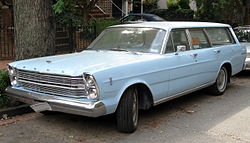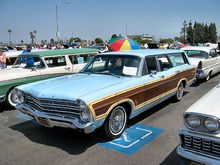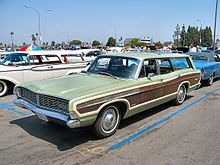- Ford Country Squire
-
Ford Country Squire 
Manufacturer Ford Motor Company Production 1951–1991 Class Full-size station wagon Body style 5-door station wagon Layout FR layout The Ford Country Squire was a full-size station wagon built by the Ford Motor Company from 1951 until 1991, encompassing seven model generations. The Country Squire was based on Ford's full-size car line and was the premium station wagon in Ford's model range. The Country Squire was initially built as a "woodie". After the mid-1950s the rear body was composed of fiberglass covered by a vinyl appliqué printed to simulate wood. Later versions featured an all-steel body and are best remembered for featuring body sides and a tailgate covered by simulated wood trim and panels, however the Country Squire could be purchased without them. Models without simulated wood trim were marketed as the Country Sedan and Ranch Wagon between 1952 and 1974; subsequently, all full-size Ford wagons were sold as Country Squires.
The Country Squire was based on the Custom DeLuxe series in 1951, the Crestline from 1952 to 1954, the Fairlane from 1955 through 1958, Galaxie 1959 through 1966, and the LTD/LTD Crown Victoria from 1967 through 1991. Due to declining sales, Ford elected to exit the full-size station wagon market after 1991.
The Colony Park was the equivalent model sold by Ford's Mercury division.
Contents
First generation (1951–1954)
First generation 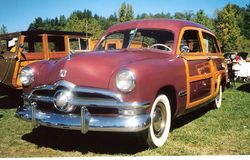
Production 1951–1954 Related Lincoln Continental
Ford CustomlineThe first generation Country Squire was a "woodie". The frame, fenders and hood were made of steel; the rear of the car's body was made of wood. From the mid 1950s onward, the rear body was composed of fiberglass covered by a plastic appliqué printed to simulate wood.
Second generation (1955–1958)
Second generation 
Production 1955–1958 Related Edsel Bermuda
Lincoln Continental
Ford FairlaneThird generation (1959–1964)
Third generation 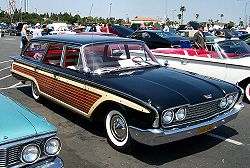
Production 1959–1964 Related Ford Galaxie
Ford Country Sedan
Mercury Commuter
Mercury Colony Park
Mercury Meteor
Mercury Monterey
Lincoln ContinentalPrior to 1961, all Ford wagons used a two-piece tailgate assembly that required the operator to lift the rear window up and locking it into place via a mechanical support, and then drop the tail gate down to fully access the rear compartment.
For the 1961 Ford adopted a tailgate assembly that used a self-storing window feature which could either be rolled down into the gate via crank on the outside of the gate, or by an electrical motor actuated by the key or an interior switch. A safety lockout measure required that the rear window had to be fully retracted into the tailgate before the tailgate could be lowered
Fourth generation (1965–1968)
Fourth generation Production 1965–1968 Related Ford LTD
Mercury Colony Park
Ford Galaxie
Mercury Marquis
Lincoln Continental
Mercury MontereyIn 1966, all Ford wagons introduced the Magic Door Gate, engineered by Donald N. Frey,[1] which allowed the tailgate to flip down like a traditional tailgate or to open to the side as a swinging door. The Magic Door Gate was made possible through use of a traditional stationary hinge on the right, and combination of hinges along the door's left side which carried the weight of the gate as it swung outward when used as a door.
Fifth generation (1969–1972)
Fifth generation 
Production 1969–1972 Engine 302 cu in (5 L) V8
351 cu in (6 L) V8
390 cu in (6 L) V8
429 cu in (7 L) V8
400 cu in (7 L) V8Related Ford LTD
Mercury Colony Park
Ford Galaxie
Mercury Marquis
Lincoln ContinentalThe fifth generation Ford Country Squire (1969–1972) rode on an expanded 121-inch (3,100 mm) wheelbase as compared to the previous generation and included as standard a 302-cubic-inch V8. In mid 1969, the 302 cubic-inch standard engine was phased out in favor of a new standard engine, the 351 cubic-inch V8. Optional engines included the 390 cubic-inch or the 429 cubic-inch V8. In 1971, Ford offered 400 cubic-inch V8 as an option. Country Squires from 1969 and 1970 used the same body panels and varied in terms of front grille and bumper, interior trim and other minor changes. The later two years of this generation saw an extensive revision of the exterior, having only the roof and tailgate in common with the 1969-1970 models. This generation was the first to use Ford's new "Three-Way Magic Doorgate," which could swing down as a tailgate, swing out as a door with the window down, or swing out as a door with the window up (not possible with 1966-1968 wagons).
Production figures:[citation needed]
- 1969: 129,235
- 1970: 108,914
- 1971: 130,644
- 1972: 121,419
Sixth generation (1973–1978)
Sixth generation 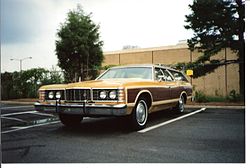
Production 1973–1978 Engine 400 cu in (7 L) V8
460 cu in (8 L) V8Length 225.7 in (5,733 mm) Related Ford LTD
Mercury Colony Park
Ford Galaxie
Mercury Marquis
Lincoln Continental
Ford TorinoFor 1973, the platform used by full-size Fords and Mercurys was redesigned and lengthened even more; the addition of 5-mph bumpers front and rear would make these the longest station wagons ever produced by Ford. Unlike its LTD sedan counterpart, the Country Squire originally came only with the 400 and 460 cubic-inch V8s, later adding the 351 Windsor engine. In 1975, Ford added hidden headlamps to the Country Squire (bringing it in line with the Mercury Colony Park and Grand Marquis); exposed headlamps were still fitted to LTD-trim wagons
Seventh generation (1979–1991)
Seventh generation 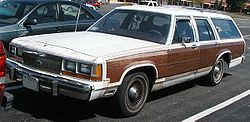
Also called Ford LTD Crown Victoria station wagon Production 1979–1991 Assembly St. Thomas, Ontario, Canada Platform Ford Panther platform Engine 4.9 L (302 cu in) 5.0 Windsor V8
5.8 L (351 cu in) 351 Windsor V8Transmission 4-speed AOD automatic (1980–1991) Wheelbase 114.3 in (2,903 mm) Length - 1979-1987
215.7 in (5,479 mm)
- 1988-1991
Width 79.3 in (2,014 mm) Height 56.5 in (1,435 mm) Related Ford LTD
Ford LTD Crown Victoria
Lincoln Continental
Lincoln Town Car
Mercury Colony Park
Mercury Grand Marquis
Mercury MarquisIn 1979, Ford became the last American automaker to downsize its full-size car lines; the Panther platform became the basis for all full-size Fords, Mercurys, and Lincolns. Eleven inches shorter and nearly 1000 pounds lighter, the redesigned Country Squire retained the 8-passenger seating capability with only slightly reduced cargo capacity. The big-block 400 and 460 cubic-inch V8s were not included in the redesign, leaving the Country Squire with the 302 and 351 cubic-inch V8s; unlike General Motors station wagons, no six-cylinder or diesel engines were offered.
The 1980s saw relatively few changes to the Country Squire. In 1988, coinciding with the facelift of its LTD Crown Victoria counterpart, the Country Squire received a new front clip. Inside, new front seats with larger head restraints were added. For 1990, the dashboard was updated (for the first time since 1979) with the addition of a driver's side airbag; the outboard rear seats received 3-point seatbelts.
Discontinuation
After the mid-1980s introduction of minivans by Chrysler, Ford, and GM, sales of full-size station wagons began to decline. The primary behind the popularity of minivans were their superior cargo capacity and fuel economy despite taking up less garage space; by 1990, Ford's Aerostar had overtaken all competitors in sales with the exception of the Chrysler minivans. Although Ford redesigned the Crown Victoria and Grand Marquis in 1992, the station wagon bodystyle was discontinued. In addition, a 1992 full-size Ford wagon would have likely competed against the wagon version of the Ford Taurus, then on its way to becoming the best-selling car in the United States.
Unique options and features
With certain versions of the Country Squire one could install an AM/FM-Cassette stereo with a combined and fully integrated Citizens' Band (CB) two-way radio, and replacement dual-purpose automatic antenna (with only one visible difference that the aerial mast was a larger diameter, and black-band at approximately half-way up). The radio would then have the appearance of an original equipment, factory radio.
Optional were opposing side-facing rear seats, which could be folded down to make a durable cargo surface. Available for use with the side-facing rear seats was a folding table with integrated magnetic checkers board. Magnets under the plastic checkers pieces would keep them from sliding on the board while the vehicle was in motion.
Behind a rear fender well was a hidden, lockable compartment, not visible when the rear seat back was in the upright position.
GM, Chrysler and AMC would adopt a similar configuration by the end of the 1960s. An advanced version of this was the 3-way tailgate which permitted opening the door sideways with the window up.
References
- ^ "The Thinker (Detroit Style)". TIME. April 21, 1967. http://www.time.com/time/magazine/article/0,9171,843628,00.html. Retrieved 2007-07-27.
External links
- Smithsonian Instution 1955 Ford Country Squire in the Smithsonian Automobile Collection
- lovefords.org Website featuring a 1963 Ford LTD Country Squire
- LTDworld.com Website featuring a 1975 Ford LTD Country Squire
- Grandmarq.net Forum dedicated to the Ford, Lincoln, and Mercury Panther Chassis
- Ford Country Squire in television and film
Ford Motor Company vehicles Ford Motor Company Current and future modelsCars Trucks/
SUVs/VansBantam • Cargo • Courier • E-Series • Econovan • EcoSport • Edge • Escape • Expedition & EL/Max • Explorer • Everest / Endeavour • F-Series & Super Duty • F-650/F-750 • Flex • Pronto • Ranger (global) • Territory • Tourneo • Tourneo Connect • Transit • Transit ConnectHistorical models1900s 1910s–1920s 1930s–1940s 1950s 1952 Ford • 1955 Ford • 1957 Ford • C-Series Trucks • Consul • Country Sedan • Courier • Del Rio • Edsel (Brand) • Fairlane • Galaxie • Mainline • Parklane • Popular • Ranchero • Squire • Taunus • Thunderbird • Versailles • Zephyr1960s 1970s 1980s 1990s 2000s Activa • Excursion • Fairlane (Australian) • Five Hundred • Freestar • Freestyle/Taurus X • GT • Ikon • Maverick (Europe) • Sportka/Streetka Category
CategoryRecent, current, and future vehicles, North American market from Ford Motor Company Passenger cars Crossover vehicles Sport Utility Vehicles Trucks/Vans Recently discontinued models
(2000s-early 2010s)Type 1980s 1990s 2000s 2010s 0 1 2 3 4 5 6 7 8 9 0 1 2 3 4 5 6 7 8 9 0 1 2 3 4 5 6 7 8 9 0 1 2 Subcompact Fiesta Festiva Aspire Fiesta Compact Pinto Escort Escort Escort Focus Focus Focus Fairmont Tempo Tempo Contour Mid-size Granada LTD Fusion Taurus Taurus Taurus Taurus Full-size LTD LTD Crown Victoria Crown Victoria Crown Victoria Country Squire Five Hundred Taurus Taurus Personal luxury Thunderbird Thunderbird Thunderbird Thunderbird Sport compact EXP EXP Probe Probe Escort ZX2 ZX2 Sports Mustang Mustang Mustang GT Categories:- Ford vehicles
- Rear wheel drive vehicles
- Station wagons
- Full-size vehicles
- 1950s automobiles
- 1960s automobiles
- 1970s automobiles
- 1980s automobiles
- 1990s automobiles
- Vehicles introduced in 1951
- Motor vehicles manufactured in the United States
- Ford Panther platform
Wikimedia Foundation. 2010.

